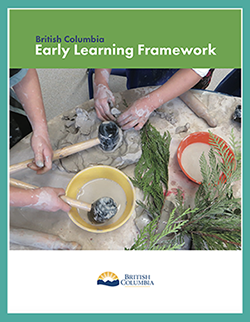
Module 2: Rethinking Learning and Practice
Example: Forest Glue
Hand-In-Hand Early Years Nature Education Program is an outdoor educational program located in the Comox Valley and Campbell River that is designed to offer a unique early childhood learning experience for children two to five years of age. The educators and children in the program developed this pedagogical narration about a journey in the forest using natural materials to hold and stick objects together.

In partnership with the interest and creativity of the children, knowledge of the educators, and an environment that supported the children's ideas, we were able to make the forest glue. Click the button below to learn more.
Our forest friends (the children in the program) came to the educators with a problem. They said, "We need rope" and "We want to tie sticks together.”
We searched through the forest and found lots and lots of ivy. One child commented on how the ivy is bad for the forest because it hurts other trees. We talked about how ivy is invasive to our forests and others commented on how they worked together to remove the ivy. Well, problem solved. We can harvest the ivy and use it as rope.
We began learning to tie ivy together and weave with it. However, there were challenges. The children commented that, “It's hard to attach things" and "Ivy keeps breaking.”

While playing by the creek, the idea came up of using ivy and wood to make a boat.
We were successful with wrapping enough ivy to create a boat that we called a "stick raft.”
The discussion continued and curiosity built around attaching other things together. "What else can we use?"
Finding sap in the forest accidentally, while climbing and getting their fingers sticky, sparked some new ideas.
"All sap is sticky" and "We could stick stuff with sap.”
Collecting sap is the first step in making forest glue.

We found plenty of sap from a stump, left in place when a tree fell during a storm last year. It was in one of our well-loved play areas.
An educator showed her forest friends what the forest glue sticks could look like.
The forest friends were introduced to all the materials that could be used to make the forest glue sticks. They also had a conversation about the process.

Everyone watched a demonstration of crushing up charcoal to add to the forest glue. To prepare the pitch glue, the educator separated the pitch over a fire at home, and the tar like substance was mixed with ground up charcoal. The method was explained to the children so that we could try it again later.
We experimented with different surfaces and textures that the glue can stick to, using different sized sticks. We soon took note that smaller sticks were best to make “snowflakes.”
Children worked with an educator to glue sticks together.

The project expanded: One child had an idea. He could use forest glue sticks to make a boat!
He took the project home to work on it together with his family.
Using wood found in the forest next to his school, he drilled holes. He then made a sail and attached a rope.
The next day, he brought his boat back to school and used some forest glue to secure the mast.

